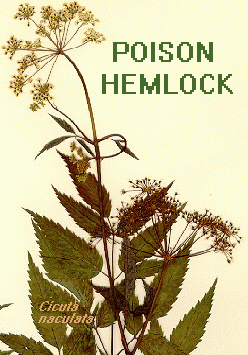
POISON HEMLOCK AND COWBANE are NOT evergreens at all, but deadly poisonous herbs of the Apiaceae Family, which makes them close relatives of Parsley, Caraway, Carrots, and Parsnips. In fact, the leaves of young Poison Hemlock resemble those of Carrots. Fortunately, the mature plant grows tall, with many tiny, white flowers in umbrella-like clusters above smooth hollow stalks that are often marked with purple spots. Two toxic species are commonly found in Nova Scotian ditches, pastures & wetlands. POISON LOCATION: All parts of the plant containing the yellow, oily sap are poisonous, but especially the leaves.
POISON TYPE:
Alkaloids, structurally related to nicotine. The toxin produces a similar stimulation before severely depressing the nervous system.
TYPICAL POISONING SCENARIO:
Accidental consumption by livestock, by children who are attracted by the flowers, or by adults who mistake POISON HEMLOCK for Caraway, which it resembles. It pays to take care in identifying the edible members of this plant family. If you are in any doubt, bruise the plant in question; POISON HEMLOCK will give off a strong, unpleasant odour said to be like that of mice.
SYMPTOMS:
Brief initial stimulation, followed by severe depression of the nervous sytem, paralysis, and death. The plants are more likely to be fatal for children than adults.
The poisonous qualities of these plants have long been known. In ancient Greece, the philosopher Socrates died in 399BCE of drinking a potent solution of POISON HEMLOCK, which was favoured by his countrymen as a "humane" method of execution.
The bane in COWBANE, on the other hand, comes from the Anglo-
Saxon word, "bana", meaning
"murderer or destroyer." This- and other old, English
na*mes like Flgeabane, Dogbane and BANEBERRY, have come to
reflect the creatures thought to be killed or repelled by the
plants.

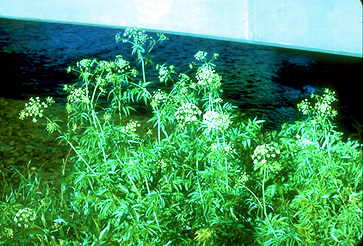
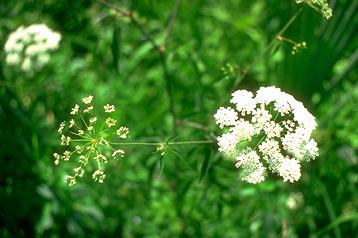
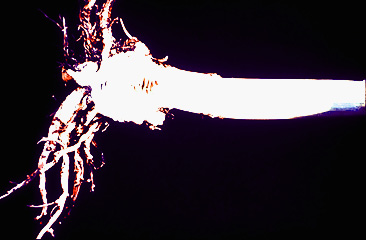
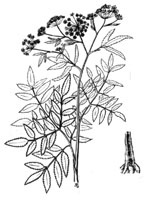
SPOTTED WATER-HEMLOCK, WATER-HEMLOCK, SPOTTED COWBANE
Cicuta maculata
(parsnip family)
TOXICITY RATING: High. This is one of the most toxic plants in the U.S.
ANIMALS AFFECTED: All animals can be affected, but cattle are especially at risk.
DANGEROUS PARTS OF PLANT: The roots contain the highest concentration of toxin, but all parts are toxic.
CLASS OF SIGNS: Nervousness, breathing difficulties, muscle tremors, collapse, convulsions (seizures), death (which may be sudden).
PLANT DESCRIPTION: The perennial stem of water-hemlock (fig. 27) may grow to 7 feet from its cluster of 2 to 8 fleshy or tuberous roots. Stems are smooth, branching, swollen at the base, purple-striped or mottled, and hollow except for partitions at the junction of the root and stem (fig. 27A). A yellow, oily liquid smelling like parsnips exudes from cut stems and roots. Leaves are alternate, two to three times pinnately compound, and toothed, with the leaf veins extending to the leaf notches. Leaf petioles partially sheath the stems. The small white flowers are borne in flat-topped, umbrella-like clusters at the tips of stems and branches. Seed pods are small and dry with rounded, prominent ribs. Water-hemlock is found in swampy areas and marshes, wet meadows and pastures, and along streambanks and low roadsides.
SIGNS: This plant is considered to be one of the most toxic plants in the United States since so little of it needs to be consumed to cause death. Humans have been killed after only one or two bites of what they thought were "parsnips" (water hemlock root resembles a parsnip). Cattle are the primary species affected, hence the name "cowbane", especially in early spring when the plants are smaller and apparently more palatable and the roots are easily pulled up. Animals may also be poisoned if water hemlock is plowed under or if ground is reclaimed, since this may expose the root. Toxicity decreases through the growing season, and the toxicity of above-ground parts may be negligible when dry. The roots however are toxic at all times, even when dry. Animals have been poisoned by drinking water that had been contaminated with trampled water hemlock roots.
The toxin is cicutoxin, a yellow, viscous resin with a carrot-like odor, which affects the central nervous system. The toxic dose (the dose needed to cause clinical signs) and the lethal dose are nearly the same, with a little more than 1 gram of water hemlock per kilogram of body weight able to kill sheep, and 8 ounces (approximately 230 grams) will kill a horse.
Once the animal has ingested even a small amount of the plant, signs will develop within an hour, and as soon as 10 to 15 minutes. The syndrome is typically very violent. Stimulation of the central nervous system begins with nervousness, and dilated pupils. Later, muscle tremors occur, the animal has difficulty breathing, falls down and goes into convulsions. Death, from respiratory paralysis and terminal convulsions, is a typical outcome, occurring within 30 minutes of the onset of signs. If a sublethal dose is consumed, and the animal survives for 4 to 6 hours (or in one report, over 2 hours), the animal may recover, but may suffer from temporary or permanent damage to heart and/or skeletal muscle.
FIRST AID: If animals are seen eating water hemlock, especially the roots, get all animals away from the plant, and call a veterinarian immediately. Emergency measures (emptying the stomach or rumen and the use of medications to control seizures) may be tried, but death may still occur. The seizures cause severe damage to the heart and skeletal muscle, and this damage can be avoided if the seizures are controlled. However, this is rarely possible under farm and field conditions since the toxin acts so quickly.
SAFETY IN PREPARED FEEDS: The above-ground parts of water hemlock decrease in toxicity over the growing season and lose additional toxin with drying. Therefore, the hay may not cause clinical toxicosis, but it is still advisable not to feed hay, or other prepared feeds, that contain water hemlock. The root is never safe, and remains toxic when dry, and should never be fed.
PREVENTION: Do not allow livestock (especially cattle) to graze in areas containing water hemlock. Prevent access to these areas or completely remove the plant (most importantly the roots) prior to introducing livestock, especially in the spring or when the roots may be exposed due to plowing, ditch maintenance, or other such activity. Never allow water hemlock to be incorporated into hay or other prepared feeds.
![]()
![]()
 Wildflower
Seed For Sale
Wildflower
Seed For Sale